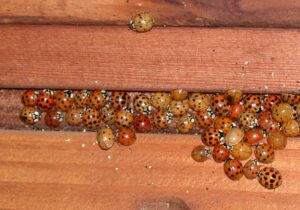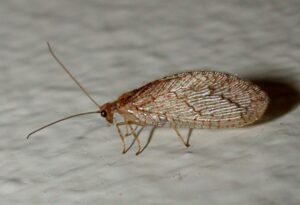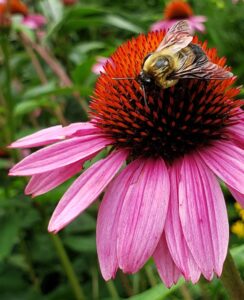As the growing season winds down and cooler temperatures approach (despite today’s unseasonable 81 degrees F), many beneficial bugs begin searching for their winter hideaways. While many people see fallen leaves as just more plant waste to dispose of, some of our beneficial bugs see a cozy bed to bundle up in for the winter. Insects have a variety of strategies to survive freezing temperatures, but common overwintering sites include under leaf litter, inside hollow stems, buried underground, or tucked away in the crevices of tree bark. Of course, our homes may offer more luxurious winter accommodations to some insects. Here’s a closer look at how a few beneficial bugs prepare for winter.
Lady Beetles, in their adult stage, are among the most recognizable beneficial insects, especially this time of year as they seek shelter in our homes (Fig. 1). Not all lady beetles overwinter in our windowsills; native beetles can survive Indiana’s winter outdoors in a state of diapause, similar to hibernation. As temperatures drop, adult lady beetles huddle together under leaf litter and in tree cavities as they enter diapause. During diapause, their metabolism slows, and they will remain inactive until spring. Huddling together and slowing their metabolism isn’t always enough; beetles also have an ability called supercooling, where proteins act like antifreeze, lowering the freezing point of the fluids in their bodies and preventing ice from forming.
- Figure 1. Asian lady beetles seek shelter from cold temperatures inside homes and often congregate in the crevices of window frames. Photo Credit: John Obermeyer, Purdue Integrated Pest Management Specialist.
Brown Lacewing (Fig. 2) may be less recognizable than lady beetles, since they are small and most active at dusk and after dark, but these voracious predators of soft-bodied garden pests play an important role in our landscapes. Much like lady beetles, brown lacewings will enter into diapause with the cooler temperatures. Unlike lady beetles, brown lacewings can overwinter as adults, larvae, or pupae. Regardless of stage, they seek a winter shelter amongst plant debris or tucked into tree bark.
- Figure 2. Adult brown lacewings are only 1/5 to 2/5 inch long. Brown lacewings, both the adult and larvae stage, are beneficial predators of soft-bodied pests such as aphids. Photo Credit: John Obermeyer, Purdue Integrated Pest Management Specialist.
The bumble bee may not prey on garden pests, but it is a pollination powerhouse (Fig. 3). While there are many different species in the Midwest, bumble bees nest in pre-existing cavities such as abandoned rodent burrows or even an abandoned bird house. A new queen bee emerges in early fall to mate before overwintering under leaf debris in diapause. Once temperatures warm in spring, the queen bee emerges to start a new colony, laying eggs of the season’s worker bees.
- Figure 3. Bumble bee on purple coneflower. Indiana is home to 49 bumble bee species. Photo credit: Karen Mitchell, Purdue Home Horticulture Specialist.
Then there are the snowbirds: unlike most Indiana insects, monarch butterflies avoid freezing temperatures altogether by migrating to warmer climates. Whether the insect avoids or tolerates the freezing temperatures, it’s important for gardeners to consider the overwintering sites of these beneficial bugs when deciding what to do with the loads and loads of leaf litter. Leaf litter not only shelters beneficial bugs, but also serves as a free mulch for trees and landscape beds, enriching both gardens and natural ecosystems.


